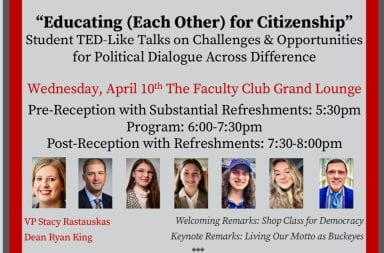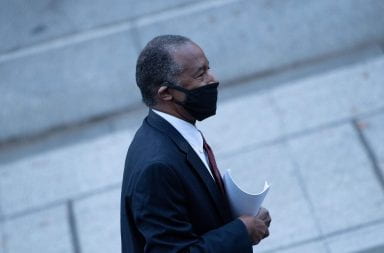
Just over a month before Ohio voters are to vote on a proposed abortion rights amendment, state attorneys and abortion providers were at the Ohio Supreme Court. Credit: John Pana/via TNS
Despite being an off year for elections, 2023 has become a contentious campaign year with high turnout rates and expensive campaigns, as seen with Ohio’s impromptu August election.
Traditionally, August elections are mired with low turnout. Last year, the August primary election had a turnout rate of 8.01 percent. This year, though, the special election jumped to a rate of 39.03 percent.
The upcoming Nov. 7 election is also expected to generate high numbers at the polls — why?
Since the overturning of Roe v. Wade, which effectively placed the regulation of abortion into the hands of states, citizens in red states with strict abortion laws turned to referendums — issues decided by voters instead of the legislature — to expand access to the procedure, as seen in Kentucky, Kansas, Montana and now Ohio in the form of Issue 1 in the November ballot.
An issue by the same name, which appeared on the ballot for the Aug. 8 special election, was perceived by many as an effort to make it harder to place an abortion amendment on the ballot by altering the amount and range of signatures needed to get an issue on the ballot and raising the percent needed to pass such issues from 50 to 60 percent.
This quickly transformed into a heated race, with proponents of the issue raising $4.8 million, and opponents raising a total of $14.8 million. In the end, opponents of the issue won with over 57 percent voting against Issue 1.
Herb Asher, professor emeritus in the Department of Political Science, said the unexpectedly high voter turnout is partially due to those who organized against it and the resources they had.
“I think enough people were angry, upset with what the Republican legislature was doing in trying to take away the right of the people to propose constitutional amendments,” Asher said.
According to Thomas Wood, associate professor in the Department of Political Science, the impact abortion has on voter turnout will continue to be seen while it remains on the ballot.
“There was a big mismatch between the policy agenda and the mainstream American public opinion. Once the mismatch is resolved, abortion will recede as a political issue and partisanship will retake its place as the principal political determinant of how people vote in these elections,” Wood said. “But while abortion remains on the ballot in a bunch of these states, it will be the key to provide an advantage to Democratic office-seekers in most places.”
Reports have shown high support for the restoration of abortion access. Three in four young people believe abortion should be legal in all or most cases, with two in five saying the overturning of Roe made them more likely to vote in 2022.
But this might only help Democrats win in places where the issue is salient, according to Wood.
“In places where abortion ‘wasn’t on the ballot,’ that is to say, in a state in New York, where there are massive Democratic advantages in the state, you did see a pretty big move to the Republican side in state races,” Wood said. “In places where abortion was a more salient political question, where people could see an instrumental relationship between how they voted and the likelihood of abortion rights being restricted in their particular state, we saw a much more muted success for Republican candidates.”
Even before Roe v. Wade was overturned in 2022, however, voter participation among college students was on the rise, according to data from the All In Campus Democracy Challenge. In 2016, the voting rate for Ohio State’s main campus was 59.1 percent, compared to an average institutional rate of 50 percent. In 2020, the voting rate on campus rose to 75 percent, compared to an average institutional rate of 66 percent.
There isn’t one major contributor to increased voter participation rates, but some have pointed to the efforts by various campus organizations, like OSU Votes, as an asset to increasing political participation amongst Ohio State students.
“I think more students — especially with social media and OSU Votes being a predominant factor on campus — are more aware of what’s happening and how they can vote and how they can register, and the resources that are available to them,” Meagen Rinard, assistant director of community and civic engagement with the Office of Student Life at Ohio State, said. “…just having that central student-to-student focus of increasing voter awareness, voter engagement and voter registration, I think, has led largely to these jumps that we’re seeing today.”
But Asher believes it is more attributed to the contentious, high-stakes nature of these elections, and how direct these ballot measures have been in relation to legislation.
“Why might turnout be very, very high this year on campus? Because the reproductive rights amendment will be on the ballot; because recreational marijuana will be on the ballot and young people can see the relevance of that in their lives,” Asher said. “So we might really see an unusual pattern this year where young people are turning out at a higher rate in an odd year in a basically non-candidate election year than they would be in an even year.”
Wood agreed, believing political polarization to be a major driving force for people to participate in elections.
“We live in a time of intensely deep partisan hostility. Americans feel incredible hostility towards the other political team, so to speak. That tends to coincide with high levels of participation,” Wood said. “So I don’t know if it’s the Supreme Court driving young people to vote at a high level. I’m not sure it’s that. I think it’s instead the fact that people really despise the other side of the coalition at very high rates, and that tends to be a reliable spur to participate.”
Students can continue to register to vote on the Ohio Secretary of State’s website until Oct. 10 for the November election.


